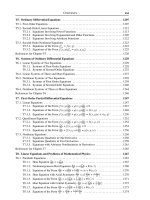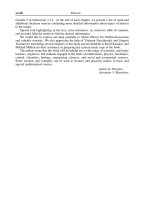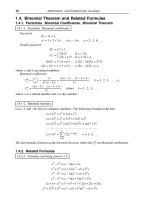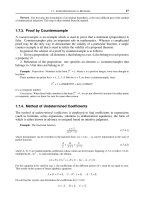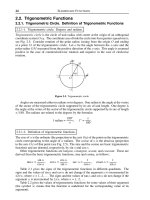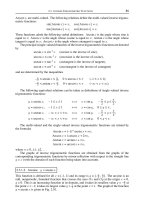Handbook of mathematics for engineers and scienteists part 10 pdf
Bạn đang xem bản rút gọn của tài liệu. Xem và tải ngay bản đầy đủ của tài liệu tại đây (308.72 KB, 7 trang )
2.3. INVERSE TRIGONOMETRIC FUNCTIONS 31
Arccot x, are multi-valued. The following relations define the multi-valued inverse trigono-
metric functions:
sin
Arcsin x
= x,cos
Arccos x
= x,
tan
Arctan x
= x,cot
Arccot x
= x.
These functions admit the following verbal definitions: Arcsin x is the angle whose sine is
equal to x; Arccos x is the angle whose cosine is equal to x;Arctanx is the angle whose
tangent is equal to x; Arccot x is the angle whose cotangent is equal to x.
The principal (single-valued) branches ofthe inverse trigonometric functions are denoted
by
arcsin x ≡ sin
–1
x (arcsine is the inverse of sine),
arccos x ≡ cos
–1
x (arccosine is the inverse of cosine),
arctan x ≡ tan
–1
x (arctangent is the inverse of tangent),
arccot x ≡ cot
–1
x (arccotangent is the inverse of cotangent)
and are determined by the inequalities
–
π
2
≤ arcsin x ≤
π
2
, 0 ≤ arccos x ≤ π (–1 ≤ x ≤ 1);
–
π
2
<arctanx <
π
2
, 0 < arccot x < π (–∞ < x < ∞).
The following equivalent relations can be taken as definitions of single-valued inverse
trigonometric functions:
y =arcsinx,–1 ≤ x ≤ 1 ⇐⇒ x =siny,–
π
2
≤ y ≤
π
2
;
y = arccos x,–1 ≤ x ≤ 1 ⇐⇒ x =cosy, 0 ≤ y ≤ π;
y =arctanx,–∞ < x <+∞⇐⇒x =tany,–
π
2
< y <
π
2
;
y = arccot x,–∞ < x <+∞⇐⇒x =coty, 0 < y < π.
The multi-valued and the single-valued inverse trigonometric functions are related by
the formulas
Arcsin x =(–1)
n
arcsin x + πn,
Arccos x =
arccos x + 2πn,
Arctan x =arctanx + πn,
Arccot x = arccot x + πn,
where n = 0,
1, 2,
The graphs of inverse trigonometric functions are obtained from the graphs of the
corresponding trigonometric functions by mirror reflection with respect to the straight line
y = x (with the domain of each function being taken into account).
2.3.1-2. Arcsine: y =arcsinx.
This function is defined for all x [–1, 1] and its range is y [–
π
2
,
π
2
]. The arcsine is an
odd, nonperiodic, bounded function that crosses the axes Ox and Oy at the origin x = 0,
y = 0. This is an increasing function in its domain, and it takes its smallest value y =–
π
2
at
the point x =–1; it takes its largest value y =
π
2
at the point x = 1. The graph of the function
y =arcsinx is given in Fig. 2.10.
32 ELEMENTARY FUNCTIONS
2.3.1-3. Arccosine: y = arccos x.
This function is defined for all x [–1, 1], and its range is y [0, π]. It is neither odd nor
even. It is a nonperiodic, bounded function that crosses the axis Oy at the point y =
π
2
and
crosses the axis Ox at the point x = 1. This is a decreasing function in its domain, and at
the point x =–1 it takes its largest value y = π; at the point x = 1 it takes its smallest value
y = 0.Forallx in its domain, the following relation holds: arccos x =
π
2
–arcsinx.The
graph of the function y = arccos x is given in Fig. 2.11.
O
1
yxarcsin=
x
y
1
π
2
π
2
Figure 2.10. The graph of the function y =arcsinx.
O
1
π
x
y
yx= arccos
1
π
2
Figure 2.11. The graph of the function y = arccos x.
2.3.1-4. Arctangent: y =arctanx.
This function is defined for all x, and its range is y (–
π
2
,
π
2
). The arctangent is an odd,
nonperiodic, bounded function that crosses the coordinate axes at the origin x = 0, y = 0.
This is an increasing function on the real axis with no points of extremum. It has two
horizontal asymptotes: y =–
π
2
(as x → –∞)andy =
π
2
(as x → +∞). The graph of the
function y =arctanx is given in Fig. 2.12.
2.3.1-5. Arccotangent: y = arccot x.
This function is defined for all x, and its range is y (0, π). The arccotangent is neither odd
nor even. It is a nonperiodic, bounded function that crosses the axis Oy at the point y =
π
2
and does not cross the axis Ox. This is a decreasing function on the entire real axis with
no points of extremum. It has two horizontal asymptotes y = 0 (as x → +∞)andy = π (as
x →–∞). For all x, the following relation holds: arccot x =
π
2
–arctanx. The graph of the
function y = arccot x is given in Fig. 2.13.
O
1
x
y
1
yxarctan=
π
2
π
2
Figure 2.12. The graph of the function y =arctanx.
O
1
x
y
π
1
yxarccot=
π
2
Figure 2.13. The graph of the function y = arccot x.
2.3. INVERSE TRIGONOMETRIC FUNCTIONS 33
2.3.2. Properties of Inverse Trigonometric Functions
2.3.2-1. Simplest formulas.
sin(arcsin x)=x, cos(arccos x)=x,
tan(arctan x)=x, cot(arccot x)=x.
2.3.2-2. Some properties.
arcsin(–x) = – arcsin x,
arctan(–x) = – arctan x,
arccos(–x)=π – arccos x,
arccot(–x)=π – arccot x,
arcsin(sin x)=
x – 2nπ if 2nπ –
π
2
≤ x ≤ 2nπ +
π
2
,
–x + 2(n + 1)π if (2n + 1)π –
π
2
≤ x ≤ 2(n + 1)π +
π
2
,
arccos(cos x)=
x – 2nπ if 2nπ ≤ x ≤ (2n + 1)π,
–x + 2(n + 1)π if (2n + 1)π ≤ x ≤ 2(n + 1)π,
arctan(tan x)=x – nπ if nπ –
π
2
< x < nπ +
π
2
,
arccot(cot x)=x – nπ if nπ < x <(n + 1)π.
2.3.2-3. Relations between inverse trigonometric functions.
arcsin x+arccos x =
π
2
,arctanx+arccot x =
π
2
;
arcsin x =
⎧
⎪
⎪
⎪
⎪
⎪
⎪
⎨
⎪
⎪
⎪
⎪
⎪
⎪
⎩
arccos
√
1 –x
2
if 0 ≤ x ≤ 1,
– arccos
√
1 –x
2
if –1 ≤ x ≤ 0,
arctan
x
√
1 –x
2
if –1 < x < 1,
arccot
√
1 –x
2
x
–π if –1 ≤ x < 0;
arccos x =
⎧
⎪
⎪
⎪
⎪
⎪
⎪
⎨
⎪
⎪
⎪
⎪
⎪
⎪
⎩
arcsin
√
1 –x
2
if 0 ≤ x ≤ 1,
π –arcsin
√
1 –x
2
if –1 ≤ x ≤ 0,
arctan
√
1 –x
2
x
if 0 < x ≤ 1,
arccot
x
√
1 –x
2
if –1 < x < 1;
arctan x =
⎧
⎪
⎪
⎪
⎪
⎪
⎪
⎪
⎪
⎪
⎪
⎨
⎪
⎪
⎪
⎪
⎪
⎪
⎪
⎪
⎪
⎪
⎩
arcsin
x
√
1 +x
2
for any x,
arccos
1
√
1 +x
2
if x ≥ 0,
– arccos
1
√
1 +x
2
if x ≤ 0,
arccot
1
x
if x > 0;
arccotx =
⎧
⎪
⎪
⎪
⎪
⎪
⎪
⎪
⎪
⎪
⎪
⎨
⎪
⎪
⎪
⎪
⎪
⎪
⎪
⎪
⎪
⎪
⎩
arcsin
1
√
1 +x
2
if x > 0,
π –arcsin
1
√
1 +x
2
if x < 0,
arctan
1
x
if x > 0,
π +arctan
1
x
if x < 0.
2.3.2-4. Addition and subtraction of inverse trigonometric functions.
arcsin x +arcsiny =arcsin
x
1 – y
2
+ y
√
1 – x
2
for x
2
+ y
2
≤ 1,
arccos x
arccos y = arccos
xy
(1 – x
2
)(1 – y
2
)
for x y ≥ 0,
34 ELEMENTARY FUNCTIONS
arctan x +arctany =arctan
x + y
1 – xy
for xy < 1,
arctan x –arctany =arctan
x – y
1 + xy
for xy >–1.
2.3.2-5. Differentiation formulas.
d
dx
arcsin x =
1
√
1 – x
2
,
d
dx
arccos x =–
1
√
1 – x
2
,
d
dx
arctan x =
1
1 + x
2
,
d
dx
arccot x =–
1
1 + x
2
.
2.3.2-6. Integration formulas.
arcsin xdx= x arcsin x +
√
1 – x
2
+ C,
arccos xdx= x arccosx –
√
1 – x
2
+ C,
arctan xdx= x arctanx –
1
2
ln(1 + x
2
)+C,
arccot xdx= x arccotx +
1
2
ln(1 + x
2
)+C,
where C is an arbitrary constant.
2.3.2-7. Expansion in power series.
arcsin x = x +
1
2
x
3
3
+
1×3
2×4
x
5
5
+
1×3×5
2×4×6
x
7
7
+ ···+
1×3×···× (2n – 1)
2×4×···× (2n)
x
2n+1
2n + 1
+ ··· (|x| < 1),
arctan x = x –
x
3
3
+
x
5
5
–
x
7
7
+ ···+(–1)
n–1
x
2n–1
2n – 1
+ ··· (|x| ≤ 1),
arctan x =
π
2
–
1
x
+
1
3x
3
–
1
5x
5
+ ···+(–1)
n
1
(2n – 1)x
2n–1
+ ··· (|x| > 1).
The expansions for arccos x and arccot x can be obtained from the relations arccos x =
π
2
–arcsinx and arccot x =
π
2
–arctanx.
2.4. Hyperbolic Functions
2.4.1. Definitions. Graphs of Hyperbolic Functions
2.4.1-1. Definitions of hyperbolic functions.
Hyperbolic functions are defi ned in terms of the exponential functions as follows:
sinh x =
e
x
– e
–x
2
,coshx =
e
x
+ e
–x
2
,tanhx =
e
x
– e
–x
e
x
+ e
–x
,cothx =
e
x
+ e
–x
e
x
– e
–x
.
The graphs of hyperbolic functions are given below.
2.4. HYPERBOLIC FUNCTIONS 35
2.4.1-2. Hyperbolic sine: y =sinhx.
This function is defined for all x and its range is the entire y-axis. The hyperbolic sine is an
odd, nonperiodic, unbounded function that crosses the axes Ox and Oy at the origin x = 0,
y = 0. This is an increasing function in its domain with no points of extremum. The graph
of the function y =sinhx is given in Fig. 2.14.
2.4.1-3. Hyperbolic cosine: y =coshx.
This function is defined for all x, and its range is y [1,+∞). The hyperbolic cosine is
a nonperiodic, unbounded function that crosses the axis Oy at the point 1 and does not
cross the axis Ox. This function is decreasing on the interval (–∞, 0) and is increasing on
the interval (0,+∞); it takes its smallest value y = 1 at x = 0. The graph of the function
y =coshx is given in Fig. 2.15.
O
1
1
2
x
y
1
1
2
yxsinh=
Figure 2.14. The graph of the function y =sinhx.
O
1
1
2
2
3
4
x
y
1
2
yxcosh=
Figure 2.15. The graph of the function y =coshx.
2.4.1-4. Hyperbolic tangent: y =tanhx.
This function is defi ned for all x, and its range is y (–1, 1). The hyperbolic tangent is an
odd, nonperiodic, bounded function that crosses the coordinate axes at the origin x = 0, y = 0.
This is an increasing function on the entire real axis and has two horizontal asymptotes:
y =–1 (as x → –∞)andy = 1 (as x → +∞). The graph of the function y =tanhx is given
in Fig. 2.16.
2.4.1-5. Hyperbolic cotangent: y =cothx.
This function is defined for all x ≠0, and its range consists of all y (–∞,–1)andy (1,+∞).
The hyperbolic cotangent is an odd, nonperiodic, unbounded function that does not cross
the coordinate axes. This is a decreasing function on each of the semiaxes of its domain;
it has no points of extremum and does not cross the coordinate axes. It has two horizontal
asymptotes: y =–1 (as x → –∞)andy = 1 (as x → +∞). The graph of the function
y =cothx is given in Fig. 2.17.
36 ELEMENTARY FUNCTIONS
O
1
1
2
x
y
1
1
2
yxtanh=
Figure 2.16. The graph of the function y =tanhx.
O
1
x
y
1
yxcoth=
Figure 2.17. The graph of the function y =cothx.
2.4.2. Properties of Hyperbolic Functions
2.4.2-1. Simplest relations.
cosh
2
x –sinh
2
x = 1,
sinh(–x)=–sinhx,
tanh x =
sinh x
cosh x
,
tanh(–x)=–tanhx,
1 –tanh
2
x =
1
cosh
2
x
,
tanh x coth x = 1,
cosh(–x)=coshx,
coth x =
cosh x
sinh x
,
coth(–x)=–cothx,
coth
2
x – 1 =
1
sinh
2
x
.
2.4.2-2. Relations between hyperbolic functions of single argument (x ≥ 0).
sinh x =
cosh
2
x – 1 =
tanh x
√
1 –tanh
2
x
=
1
√
coth
2
x – 1
,
cosh x =
sinh
2
x + 1 =
1
√
1 –tanh
2
x
=
coth x
√
coth
2
x – 1
,
tanh x =
sinh x
√
sinh
2
x + 1
=
√
cosh
2
x – 1
cosh x
=
1
coth x
,
coth x =
√
sinh
2
x + 1
sinh x
=
cosh x
√
cosh
2
x – 1
=
1
tanh x
.
2.4.2-3. Addition formulas.
sinh(x y)=sinhx cosh y sinh y cosh x,cosh(x y)=coshx cosh y sinh x sinh y,
tanh(x
y)=
tanh x tanh y
1 tanh x tanh y
,coth(x y)=
coth x coth y 1
coth y coth x
.
2.4. HYPERBOLIC FUNCTIONS 37
2.4.2-4. Addition and subtraction of hyperbolic functions.
sinh x sinh y = 2 sinh
x
y
2
cosh
x
y
2
,
cosh x +coshy = 2 cosh
x + y
2
cosh
x – y
2
,
cosh x –coshy = 2 sinh
x + y
2
sinh
x – y
2
,
sinh
2
x –sinh
2
y =cosh
2
x –cosh
2
y =sinh(x + y)sinh(x – y),
sinh
2
x +cosh
2
y =cosh(x + y)cosh(x – y),
(cosh x
sinh x)
n
=cosh(nx) sinh(nx),
tanh x
tanh y =
sinh(x y)
cosh x cosh y
,cothx coth y =
sinh(x y)
sinh x sinh y
,
where n = 0,
1, 2,
2.4.2-5. Products of hyperbolic functions.
sinh x sinh y =
1
2
[cosh(x + y)–cosh(x – y)],
cosh x cosh y =
1
2
[cosh(x + y)+cosh(x – y)],
sinh x cosh y =
1
2
[sinh(x + y)+sinh(x – y)].
2.4.2-6. Powers of hyperbolic functions.
cosh
2
x =
1
2
cosh 2x+
1
2
,
cosh
3
x =
1
4
cosh 3x+
3
4
cosh x,
cosh
4
x =
1
8
cosh 4x+
1
2
cosh 2x+
3
8
,
cosh
5
x =
1
16
cosh 5x+
5
16
cosh 3x+
5
8
cosh x,
sinh
2
x =
1
2
cosh 2x–
1
2
,
sinh
3
x =
1
4
sinh 3x–
3
4
sinh x,
sinh
4
x =
1
8
cosh 4x–
1
2
cosh 2x+
3
8
,
sinh
5
x =
1
16
sinh 5x–
5
16
sinh 3x+
5
8
sinh x,
cosh
2n
x =
1
2
2n–1
n–1
k=0
C
k
2n
cosh[2(n –k)x]+
1
2
2n
C
n
2n
,
cosh
2n+1
x =
1
2
2n
n
k=0
C
k
2n+1
cosh[(2n –2k +1)x],
sinh
2n
x =
1
2
2n–1
n–1
k=0
(–1)
k
C
k
2n
cosh[2(n –k)x]+
(–1)
n
2
2n
C
n
2n
,
sinh
2n+1
x =
1
2
2n
n
k=0
(–1)
k
C
k
2n+1
sinh[(2n –2k +1)x].
Here, n = 1, 2, ;and C
k
m
are binomial coefficients.



